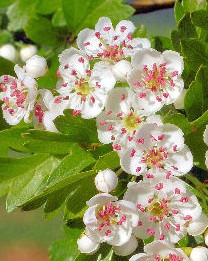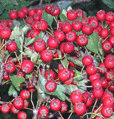 This European native is a deciduous shrub or small tree with inch long prominent thorns that are sharp and tough enough to pierce a car tire. In fact, it has been used since the Middle Ages as an animal-proof hedging plant. Thorns, however, are not its only outstanding characteristic; in mid spring it is covered with a cloud of fragrant flowers which are followed by round, half inch fruits that ripen to red in the fall and attract birds. The simple, dark green leaves are lobed and 2½ inch long. The trunk is gray-brown and bears branches that cross in all directions ultimately forming a rounded tree crown. Like other members of the rose family, English Hawthorn suffers from pest problems similar to those of apples and is especially susceptible to hawthorn leaf spot and blight. Cultivars vary in their disease resistance as well as the in color and fullness of their flowers. Prune it for a hedge or screen (with great caution), or use it as a specimen tree.
This European native is a deciduous shrub or small tree with inch long prominent thorns that are sharp and tough enough to pierce a car tire. In fact, it has been used since the Middle Ages as an animal-proof hedging plant. Thorns, however, are not its only outstanding characteristic; in mid spring it is covered with a cloud of fragrant flowers which are followed by round, half inch fruits that ripen to red in the fall and attract birds. The simple, dark green leaves are lobed and 2½ inch long. The trunk is gray-brown and bears branches that cross in all directions ultimately forming a rounded tree crown. Like other members of the rose family, English Hawthorn suffers from pest problems similar to those of apples and is especially susceptible to hawthorn leaf spot and blight. Cultivars vary in their disease resistance as well as the in color and fullness of their flowers. Prune it for a hedge or screen (with great caution), or use it as a specimen tree.
Type: Deciduous, small flowering tree or shrub
Outstanding Features: Flowers, fruits
Form: Rounded, dense,
Growth Rate: Slow to moderate
Bloom: Fragrant white to red flowers with five petals are born in corymbs in spring; .fruits ripen in fall
 Size: 15-20’ x 15-20’
Size: 15-20’ x 15-20’
Light: Full sun
Soil: Fertile, moist, well-drained
Hardiness: Zones 5-8
Pests and Diseases: Susceptible to aphids, sclae, fire blight and many of the same diseases and pests as apples.
Propagation: Cuttings
Outstanding Selection: ‘Paul’s Scarlet’ (double, pink to red flowers; often lacks fruit; very susceptible to hawthorn leaf spot and blight).
